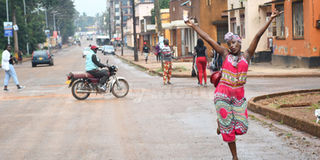Prime
Jinja: A city of rich colonial tales tied to architecture

A section of Jinja City. PHOTO/EDGAR R BATTE
What you need to know:
- Historical. Different things make Jinja stand out from the rest. The Nile, people, buildings and of course stories have all made it the adventure city, writes Edgar R. Batte .
Jinja City is unique for its historical architecture on one side and a number of adventure travel excursions on the other. You will hear many tales from locals. It is a city where you are sure to find something to do.
I was glad to join a team of local travellers on a visit to the eastern town on a public holiday. There was generally less traffic so our city tour was freer which gave us a chance to walk the streets with ease.
We were smoothly driven in the all-new Kayoola, a locally assembled bus by Kiira Motors Limited. Our tour guide, John Hillary Balyejjusa, was quite knowledgeable and funny.
He was born and bred in Jinja and has seen the town evolve even when it somehow feels like it is stuck back in time. He observed that with new entrants and the arrival of new businesses, Jinja has started losing its architectural and intangible cultural heritage.
“Unfortunately, many Ugandans, even Jinja residents, pay little attention to the beauty that the city holds so together with other Jinja enthusiasts, I have decided to encourage fellow residents to embrace this beauty and regularly organise photo walks and other activities geared towards exposing the stories behind some of the most iconic features of the city,” Balyejjusa explained.
Our first key spot was the Jinja Bridge, a picturesque recent addition. It makes a metallic canopy. A photographer would also wish to capture it at nightfall when the River Nile waters reflect colourful lights from some of the establishments that map around the waters.
We then headed to St Joseph’s Cathedral, an old church that sits on an expanseof land, and prominently so as it towers on a rise, with half bricks. The church was built by the Catholic missionary priests; the Mill Hill Fathers, in 1939.
Our guide explained that the church is dedicated to St Joseph but his statue had to be removed and buried nearby after its head was shot at by soldiers who assumed that it was a person during the 1986 liberation war that brought the National Resistance Movement to power.
As we learnt from our guide, the church became a cathedral after Jinja became a diocese in 1966. From the church, we embarked onto a city heritage tour both on the Kayoola and on foot.
The Madhvani House was our next stop. It depicts colonial architecture. It was constructed in 1919 and was the home of Muljibai Madhvani who came to Uganda to work with his uncle Vithaldas Haridas.
The structure which now houses the headquarter of the Madhvani Foundation was the first double storied building in the country. It underwent a major renovation in 2011 but it has retained a good portion of its original form.
It is located on Jinja’s Main Street. A few steps away is the Jinja Central Police Station that is prominently positioned at the corner of Main Street and Rippon Road.
It has served the same purpose since 1928, when it was constructed to deal with the rising crime brought to Jinja by the railway and taxi park. Built in the same era, in 1906 is the Jinja Post Office, an idea of Hajji Tamachi, an Indian settler, who proposed to the British to set up one.
However, he ended up funding it himself after the British claimed it wasn’t viable at the time and as such, couldn’t start up one. In the days before phones, mail dominated the day, the post office was always abuzz with people dropping and picking mail.
It is one of the ‘limping’ casualties in the face of the digitalised world. From the post office building, we headed to the Jinja Pier. It was constructed in 1912. Balyejjusa told us that the pier is considered to be the first major infrastructure to be built in Jinja.
“The pier was the terminus of Uganda’s first railway, the Busoga Railway, and served as the main outlet of Uganda until the rail head of the Uganda Railway reached Jinja in 1928,” he explained. He added, “Of recent the Busoga Railway had run into disrepair and the port was slowly rotting away. However, starting this year, thanks to Covid-19, the port is being revived as an inland port on Lake Victoria and is slowly picking up. Recently the Busoga Railway was renovated and used for the first time in decades to transport fuel.”
Our history lesson continued to the Jinja City Hall which was designed by Cobb, Powell and Freeman in the Tropical Modernist style. The offices mark Jinja’s transition from a township to a municipality.
Built in 1958, the building has council chambers, a ceremonial main hall and offices for the Jinja Mayor, Town Clerk and other officials. The colonial era structure still maintains an aura of stateliness worth beholding.

The visit to the cemetery was not solemn but enriching thanks to the tales of world war heroes who lay there in decorated concrete and well maintained lawns.
Quick Notes
Before 1906, Jinja was a fishing village that benefited from being located on long-distance trade routes. The origin of the name “Jinja” comes from the language of the two peoples (the Baganda and the Basoga) that lived on either side of the River Nile in the area.
In both languages “Jinja” means “Rock”. In most of Africa, rivers like the Nile hindered migration, this explains the ethnic boundaries along the Nile as one moves north from the river’s source on the northern shores of Lake Victoria.





